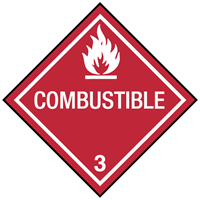
 Print
Print
Chemical Datasheet
ETHYLHEXYL ACETATE |

|
Chemical Identifiers
| CAS Number |
UN/NA Number |
DOT Hazard Label |
USCG CHRIS Code |
|
|
|
|
|
| NIOSH Pocket Guide |
International Chem Safety Card |
|
none
|
none
|
NFPA 704
General Description
A water-white liquid. Insoluble in water and is less dense than water. Flash point 180°F. Used as a solvent and in perfumes. Liquid or vapors may irritate skin and eyes. Vapors have a fruity, pleasant odor.
Hazards
Reactivity Alerts
none
Air & Water Reactions
Insoluble in water.
Fire Hazard
Special Hazards of Combustion Products: Irritating vapors and toxic gases, such as carbon monoxide, may be formed when involved in fire. (USCG, 1999)
Health Hazard
Prolonged skin contact may cause irritation. (USCG, 1999)
Reactivity Profile
ETHYLHEXYL ACETATE is an ester. Esters react with acids to liberate heat along with alcohols and acids. Strong oxidizing acids may cause a vigorous reaction that is sufficiently exothermic to ignite the reaction products. Heat is also generated by the interaction of esters with caustic solutions. Flammable hydrogen is generated by mixing esters with alkali metals and hydrides. Contact with strong oxidizers may cause vigorous reaction (USCG, 1999).
Belongs to the Following Reactive Group(s)
- Esters, Sulfate Esters, Phosphate Esters, Thiophosphate Esters, and Borate Esters
Potentially Incompatible Absorbents
No information available.
Response Recommendations
Isolation and Evacuation
Excerpt from ERG Guide 128 [Flammable Liquids (Water-Immiscible)]:
IMMEDIATE PRECAUTIONARY MEASURE: Isolate spill or leak area for at least 50 meters (150 feet) in all directions.
LARGE SPILL: Consider initial downwind evacuation for at least 300 meters (1000 feet).
FIRE: If tank, rail tank car or highway tank is involved in a fire, ISOLATE for 800 meters (1/2 mile) in all directions; also, consider initial evacuation for 800 meters (1/2 mile) in all directions. (ERG, 2024)
Firefighting
Excerpt from ERG Guide 128 [Flammable Liquids (Water-Immiscible)]:
CAUTION: The majority of these products have a very low flash point. Use of water spray when fighting fire may be inefficient. CAUTION: For mixtures containing alcohol or polar solvent, alcohol-resistant foam may be more effective.
SMALL FIRE: Dry chemical, CO2, water spray or regular foam. If regular foam is ineffective or unavailable, use alcohol-resistant foam.
LARGE FIRE: Water spray, fog or regular foam. If regular foam is ineffective or unavailable, use alcohol-resistant foam. Avoid aiming straight or solid streams directly onto the product. If it can be done safely, move undamaged containers away from the area around the fire.
FIRE INVOLVING TANKS, RAIL TANK CARS OR HIGHWAY TANKS: Fight fire from maximum distance or use unmanned master stream devices or monitor nozzles. Cool containers with flooding quantities of water until well after fire is out. For petroleum crude oil, do not spray water directly into a breached tank car. This can lead to a dangerous boil over. Withdraw immediately in case of rising sound from venting safety devices or discoloration of tank. ALWAYS stay away from tanks in direct contact with flames. For massive fire, use unmanned master stream devices or monitor nozzles; if this is impossible, withdraw from area and let fire burn. (ERG, 2024)
Non-Fire Response
Excerpt from ERG Guide 128 [Flammable Liquids (Water-Immiscible)]:
ELIMINATE all ignition sources (no smoking, flares, sparks or flames) from immediate area. All equipment used when handling the product must be grounded. Do not touch or walk through spilled material. Stop leak if you can do it without risk. Prevent entry into waterways, sewers, basements or confined areas. A vapor-suppressing foam may be used to reduce vapors. Absorb or cover with dry earth, sand or other non-combustible material and transfer to containers. Use clean, non-sparking tools to collect absorbed material.
LARGE SPILL: Dike far ahead of liquid spill for later disposal. Water spray may reduce vapor, but may not prevent ignition in closed spaces. (ERG, 2024)
Protective Clothing
Impervious clothing and gloves should be used to prevent skin contact. Where splashing is possible wear full face shield or chemical safety goggles. Use approved respirator to protect against vapors. (USCG, 1999)
DuPont Tychem® Suit Fabrics
No information available.
First Aid
Get medical attention.
INHALATION: Remove to fresh air. If breathing has stopped, give artificial respiration. If breathing is difficult, give oxygen.
EYES: Flush with water for at least 15 min., lifting lids occasionally.
SKIN: Remove contaminated clothing and shoes. Flush with water.
INGESTION: Have the victim drink water or milk. (USCG, 1999)
Physical Properties
Flash Point:
160°F
(USCG, 1999)
Lower Explosive Limit (LEL):
0.76 %
at 200°F
(USCG, 1999)
Upper Explosive Limit (UEL):
8.14 %
at 300°F
(USCG, 1999)
Autoignition Temperature: data unavailable
Melting Point: data unavailable
Vapor Pressure: data unavailable
Vapor Density (Relative to Air): data unavailable
Specific Gravity:
0.873
at 68°F
(USCG, 1999)
- Less dense than water; will float
Boiling Point:
378°F
at 760 mmHg
(USCG, 1999)
Molecular Weight:
172.27
(USCG, 1999)
Water Solubility: data unavailable
Ionization Energy/Potential: data unavailable
IDLH: data unavailable
AEGLs (Acute Exposure Guideline Levels)
No AEGL information available.
ERPGs (Emergency Response Planning Guidelines)
No ERPG information available.
PACs (Protective Action Criteria)
No PAC information available.
Regulatory Information
EPA Consolidated List of Lists
No regulatory information available.
CISA Chemical Facility Anti-Terrorism Standards (CFATS)
No regulatory information available.
OSHA Process Safety Management (PSM) Standard List
No regulatory information available.
Alternate Chemical Names
- BETA-ETHYLHEXYL ACETATE
- 2-ETHYL-1-HEXANOL ACETATE
- 2-ETHYL-1-HEXYL ACETATE
- ETHYLHEXYL ACETATE
- 2-ETHYLHEXYL ACETATE
- 1-HEXANOL, 2-ETHYL-, ACETATE
- OCTYL ACETATE


 Print
Print
